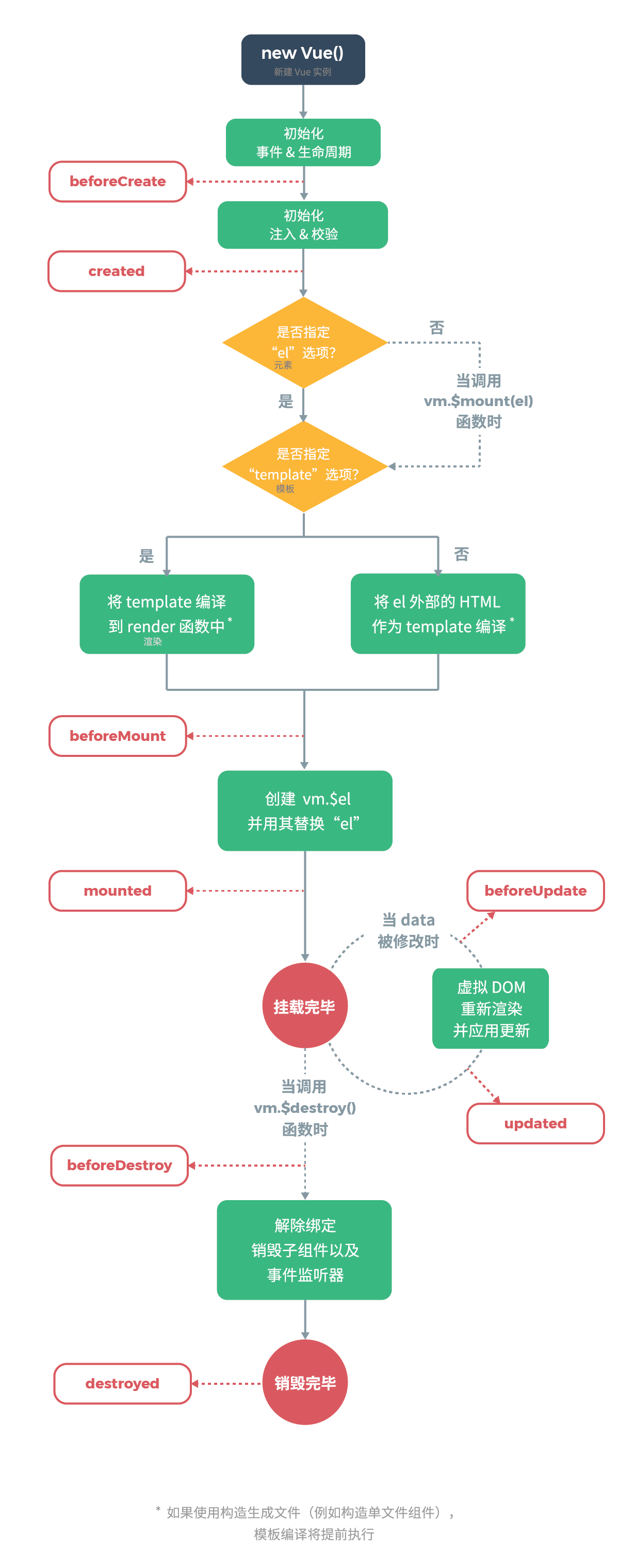【前端拾遗】VUE的生命周期函数——详解

除了数据双向绑定、virtual Dom等偏向于底层实现的知识点外,vue的生命周期函数作为应用层层面里最核心的问题,其重要程度随着你的能力提升会不断提高。
1.定义
每个 Vue 实例在被创建时都要经过一系列的初始化过程——例如,需要设置数据监听、编译模板、将实例挂载到 DOM 并在数据变化时更新 DOM 等。同时在这个过程中也会运行一些叫做生命周期钩子的函数,这给了用户在不同阶段添加自己的代码的机会。

| 生命周期钩子 | 组件状态 | 最佳实践 |
|---|---|---|
| beforeCreate | 实例初始化之后,this指向创建的实例,不能访问到data、computed、watch、methdos上的方法和数据 | 常用于初始化非响应式变量 |
| created | 实例创建完成,可访问data、computed、watch、methods上的方法和数据,未挂载到DOM,不能访问$el属性,$ref属性内容为空数组 | 常用于简单的ajax请求,页面的初始化 |
| beforeMount | 在挂载开始之前被调用,beforeMount之前,会找对对应的template,并编译成render函数 | - |
| mounted | 实例挂载到DOM上,此时可以通过DOM API获取到DOM节点,/$ref属性可以访问 | 常用于获取VNode信息和操作,ajax请求 |
| beforeupdate | 响应式数据更新时调用,发生在虚拟DOM打补丁之前 | 适合在更新之前访问现有的DOM,比如手动移除已添加的事件监听器 |
| updated | 虚拟DOM重新渲染和补丁之后调用,组件DOM已经更新,可以执行依赖于DOM的操作 | 避免在这个钩子函数中操作数据,可能陷入死循环 |
| beforeDestroy | 实例销毁之前调用。这一步,实例仍然完全可用,this仍能获取到实例 | 常用于销毁定时器、解绑全局事件、销毁插件对象等操作 |
| destroyed | 实例销毁后调用,调用后,Vue实例指示的所有东西都会解绑定,所有的事件监听器会被移除,所有的子实例也会被销毁 | - |
注意:
- created阶段的ajax请求与mounted请求的区别:前者页面视图未出现,如果请求信息过多,会导致页面长时间处于白屏状态。
接下来我们从流程和代码两个方面来说明Vue的生命周期:
2.Vue生命周期流程
- 当我们创建一个Vue实例,即new Vue(),首先会执行init函数,在init函数中会执行第一个 beforeCreated钩子函数。
- 执行beforeCreate之前,先执行mergeOptions函数,得到/$options选项,并把这个设置成Vue实例的一个属性。
- beforeCreate,设个阶段生成生命周期以及一些数据的初始化。
- 接下来执行created:这个阶段数据已经绑定在实例上,但是还没有挂载对象。
- created之后,判断instance(实例)是否含有'el'这个options选项。
- 如果没有,它会调用vm./$mount(el) 这个方法,然后执行下一步,意味着它会停止编译,生命周期结束。
- 如果有,判断是否含有template属性,如果有的话Vue将template解析成一个render function,如果没有template选项它将外部的HTML作为模板编译。
- 当render function之后才会执行beforeMounted,
这里说的不明白, 以后重写
3. 单个组件的生命周期
<template>
<div id='single'>
<h3>单个组件的生命周期函数</h3>
<button @click="singleData+= 1">更新{{singleData}}</button>
<button @click="handleDestroy">销毁</button>
</div>
</template>
<script>
export default {
data(){
return{
singleData:1
}
},
//生命周期
beforeCreate(){
this.compName = 'single'; //定义非响应式变量
console.log(`--${this.compName}--befroeCreate`);
},
created() {
console.log(`--${this.compName}--created`)
},
beforeMount() {
console.log(`--${this.compName}--beforeMount`)
},
mounted() {
console.log(`--${this.compName}--mounted`)
},
beforeUpdate() {
console.log(`--${this.compName}--beforeUpdate`)
},
updated() {
console.log(`--${this.compName}--updated`)
},
beforeDestroy() {
console.log(`--${this.compName}--beforeDestroy`)
},
destroyed() {
console.log(`--${this.compName}--destroyed`)
},
methods:{
handleDestroy(){
this.$destroy();
}
}
}
</script>
当组件加载与初始化时:
当更新组件时:
--single--beforeUpdate
--single--updated
组件销毁时:
--single--beforeDestroy
--single--destroyed
从结果我们可以看出:
- 初始化组件时,仅执行了beforeCreate/Created/beforeMount/mounted四个钩子函数
- 当改变data中定义的变量(响应式变量)时,会执行beforeUpdate/updated钩子函数
- 当切换组件(当前组件未缓存)时,会执行beforeDestory/destroyed钩子函数
- 初始化和销毁时的生命钩子函数均只会执行一次,beforeUpdate/updated可多次执行
4.父子组件之间传值
父组件:
<template>
<div id='father'>
<button @click="handleDestroy">父组件销毁</button>
<child compName='child'></child>
</div>
</template>
<script>
import child from "../components/Child.vue";
export default {
name:'Father',
components: {
child
},
//生命周期
beforeCreate() {
this.compName = 'father'; //定义非响应式变量
console.log(`--${this.compName}--befroeCreate`);
},
created() {
console.log(`--${this.compName}--created`)
},
beforeMount() {
console.log(`--${this.compName}--beforeMount`)
},
mounted() {
console.log(`--${this.compName}--mounted`)
},
beforeUpdate() {
console.log(`--${this.compName}--beforeUpdate`)
},
updated() {
console.log(`--${this.compName}--updated`)
},
beforeDestroy() {
console.log(`--${this.compName}--beforeDestroy`)
},
destroyed() {
console.log(`--${this.compName}--destroyed`)
},
methods: {
handleDestroy() {
this.$destroy();
}
}
}
</script>
子组件:
<template>
<div id='child'>
<h3>单个组件的生命周期函数</h3>
<button @click="singleData+= 1">更新{{singleData}}</button>
<button @click="handleDestroy">销毁</button>
</div>
</template>
<script>
export default {
name:'child',
props:{
compName:String
},
data(){
return{
singleData:1
}
},
//生命周期
beforeCreate(){
//this.compName = 'single'; //定义非响应式变量
console.log(`--props的值未获取,不知道compName是啥--befroeCreate`);
},
created() {
console.log(`--${this.compName}--created`)
},
beforeMount() {
console.log(`--${this.compName}--beforeMount`)
},
mounted() {
console.log(`--${this.compName}--mounted`)
},
beforeUpdate() {
console.log(`--${this.compName}--beforeUpdate`)
},
updated() {
console.log(`--${this.compName}--updated`)
},
beforeDestroy() {
console.log(`--${this.compName}--beforeDestroy`)
},
destroyed() {
console.log(`--${this.compName}--destroyed`)
},
methods:{
handleDestroy(){
this.$destroy();
}
}
}
</script>
初始化组件时,打印:
--father--befroeCreate
--father--created
--father--beforeMount
--props的值未获取,不知道compName是啥--befroeCreate
--child--created
--child--beforeMount
--child--mounted
--father--mounted
数据更新时
child--beforeUpdate
--child--updated
组件销毁时
--father--beforeDestroy
--child--beforeDestroy
--child--destroyed
--father--destroyed
从打印结果可以看出:
- 仅当子组件完成挂载后,父组件才会挂载
- 当子组件完成挂载后,父组件会主动执行一次beforeUpdate/updated钩子函数(仅首次)
- 父子组件在data变化中是分别监控的,但是在更新props中的数据是关联的(可实践)
- 销毁父组件时,先将子组件销毁后才会销毁父组件